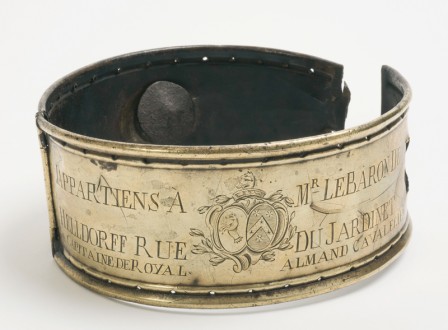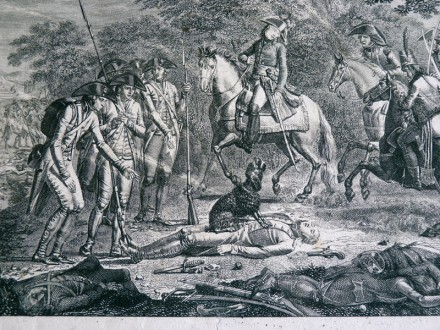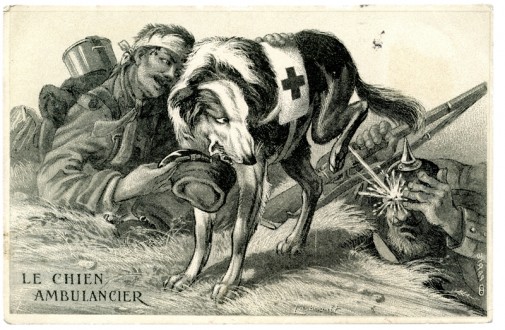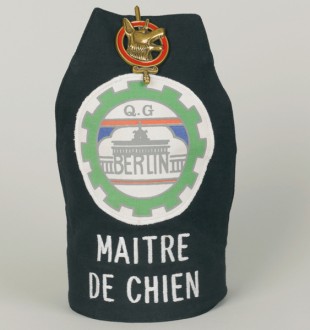
During the Spanish conquest of Mexico and Peru, Cortez and Pizarro used packs of dogs of Mastiff breed as a canine swat teams trained to attack the enemy in the most sudden and savage fashion. According to the Spanish technique known as “apperamiento“, the dogs were trained to neutralize the Natives and to disembowel and dismember them when they tried to escape. © Paris, musée de l’Armée
Dog collar made ca. 1772, on which the names of the owner, an officer, and his regiment are engraved. The quality of the craftsmanship on this collar shows that the officer was very fond of his dog. © Paris, musée de l’Armée, Dist. RMN-GP / Pascal Segrette
Dog crying over a dead soldier of the Grande Armée. In the light of the breed of dog, he could very well be Moustache, the famous dog of the Grande Armée. © Paris, musée de l’Armée
Humorous postcard showing a wounded soldier accompanied by dog from the mobile Medical Corps urinating on a spike helmet of the German soldier. A great number of these type of postcards were published during World War One
Violence. Bunkhouse, block 27. December 1943 Ravensbrück, drawing by Jeanne Letourneau (1895-1979). © Paris, musée de l’Armée, Dist. RMN-GP / Marie Bour
Armband of a dog handler of the French GHQ in Berlin. © Paris, musée de l’Armée, Dist. RMN-GP / Pascal Segrette
The Dog
Always on Duty
Dogs have always played an important role in the military world. Their obedience, acute scent, and the potential aggressiveness of certain breeds, make them a very valuable asset for the soldier. Although their utility is universally accepted, dogs have been, over time, employed in very different ways depending on the armies.
War Dogs
During Antiquity, canines fought in phalanxes in Asia Minor. Mastiffs, more particularly Mastiffs of Tibet, were trained by the Assyrians and the Persians to fight in the front ranks. In the West, in spite of the existence of hordes in the Gallic and the Germanic tribes, dogs were primarily used as sentries.
Snarling Dogs
All throughout the Middle-Ages and the Renaissance in Europe, dogs did not fight. To the contrary, they were widely used to control and pacify local communities during the wars of conquest in Asia and America. They were also used to chase fugitive slaves trying to run away from their plantations.
Dog Services
During the reign of King Louis XIV, although there was a real interest in dog service in France, the dog was above all an animal of prestige, pleasure and for the sport of hunting. In the eighteenth and early nineteenth centuries, the French Army did not keep military packs, but many brigades possessed a mascot dog. The testimonies and the representations of dogs accompanying the daily life of the soldiers abound. Mention may be made of a certain Moustâche, a barbet who took part in many of the campaigns of the Directory and the French First Empire. During the colonial wars in North Africa, dogs were used both by the Europeans and local communities.
Multi-activity
During the second half of the nineteenth century, cynophilia developed throughout Europe. Following the Franco-Prussian War of 1870, the Germans set out to develop a systematic training of war dogs. Due to the predominance of heavy weaponry on the battlefield, canine units were not trained to attack the enemy. Instead, they performed a variety of specialized missions: sentry dogs, dog carriers, patrol dogs and dispatch dogs for delivering messages to and from the front lines. They were also integrated into mobile medical units for scenting the wounded and carrying them from the battlefield.
Canine Units
When World War One broke out, Germany had more than 5,000 trained dogs while France was lagged behind as the French Ministry of War did not have faith in the supposed potential of canine units. However, in 1917, the French Army opened special training centres behind their lines, and although the organization was somewhat erratic at the beginning, good results were achieved quite rapidly.
At the end of 1918, these encouraging developments did not prevent the demobilization and the closing of the French training centres for war dogs. To the contrary, Germany opened in 1938, the largest Army canine establishment in Europe, at Kummersdorf, near Berlin. Hundreds of thousands of war dogs were trained there, some of which served as guard dogs in the concentration camps.
During the Second World War, most armies were equipped with fighting dogs. American canine units distinguished themselves by their ferocity during commando attacks. The Soviets used their dogs as kamikaze canines with explosives and sent them to enemy lines in order to blow up the chassis of German tanks, and the Japanese used dogs during their invasion of China.
At the end of the Second World War, France gained possession of 600 German Sheppard dogs that formed the base of canine units used by the French during their wars of decolonization.
Still in Operation
Dogs are still used in the Army today. They are employed as commando dogs, patrol dogs and mine-clearer dogs, and like every soldier they are given a knapsack, an identification number and are subject to be deployed to various fields of intervention.







Ajouter un commentaire